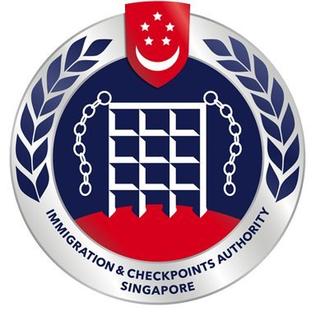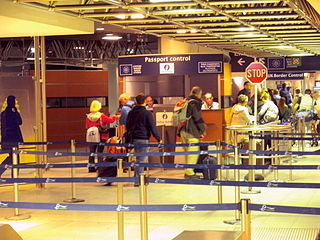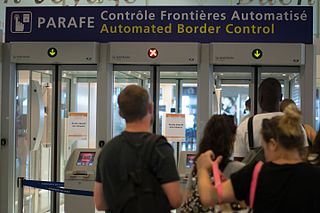
Border control comprises measures taken by governments to monitor and regulate the movement of people, animals, and goods across land, air, and maritime borders. While border control is typically associated with international borders, it also encompasses controls imposed on internal borders within a single state.

SmartGate is an automated self-service border control system operated by the Australian Border Force (ABF) and New Zealand Customs Service (NZCS) and located at immigration checkpoints in departure and arrival halls in ten Australian international airports, and 4 New Zealand international airports. SmartGates allow Australian ePassport holders and ePassport holders of a number of other countries to clear immigration controls more rapidly, and to enhance travel security by performing passport control checks electronically.

The Singapore passport is a passport issued to citizens of the Republic of Singapore. It enables the bearer to exit and re-enter Singapore freely; travel to and from other countries in accordance with visa requirements; facilitates the process of securing assistance from Singapore consular officials abroad, if necessary; and requests protection for the bearer while abroad.

The Immigration and Checkpoints Authority (ICA) is a law enforcement agency within the Ministry of Home Affairs (MHA), the border control agency responsible for frontline border control operations at air, sea and rail ports in Singapore.
Iris Recognition Immigration System (IRIS) was an initiative, launched in 2004, to provide automated clearance through UK immigration for certain frequent travellers. It functioned in "one-to-all" identification mode, searching a large database of some million enrolled frequent travellers to see if anyone matched the presenting iris. The passenger was not asked to assert any identity, e.g. by presenting a Passport or ID card which would then require only a "one-to-one" verification test against that single enrolled identity. Thus IRIS exploited the great robustness of iris recognition against making False Matches, since (unlike weak biometrics such as face recognition) it could survive the vast number of opportunities to make False Matches when searching a large database, instead of only needing to test just a single asserted identity. It was decommissioned in September 2013 in favour of e-passport entry using biometric data stored on the e-passport chip, which requires only a single asserted identity to be tested and thus could function using weaker biometrics in the simple "one-to-one" verification mode.

Visa requirements for Polish citizens are public health and administrative entry restrictions by the authorities of other states placed on citizens of Poland.

Global Entry is a program of the U.S. Customs and Border Protection service that allows pre-approved, low-risk travelers to receive expedited clearance upon arrival into the United States through automatic kiosks at select airports and via the SENTRI and NEXUS lanes by land and sea. As of May 4, 2018, Global Entry was available at 53 U.S. airports and 15 preclearance locations. By April 2018 more than five million people were enrolled in Global Entry and approximately 50,000 new applications for the program were being filed each month.

Visa requirements for Afghan citizens are administrative entry restrictions by the authorities of other states placed on citizens of Afghanistan.

Visa requirements for French citizens are administrative entry restrictions by the authorities of other states placed on citizens of France.

Visa requirements for Singapore citizens are administrative entry restrictions by the authorities of other states which are imposed on citizens of Singapore.

The visa policy of the United Kingdom is the policy by which His Majesty's Government determines visa requirements for visitors to the United Kingdom, and the Crown dependencies of Guernsey, Jersey, and the Isle of Man and those seeking to work, study or reside there.

The visa policy of Singapore deals with the requirements a traveller must meet to enter Singapore. A foreign national, depending on their country of origin, must meet certain requirements to obtain a visa, which is a permit to travel, to enter and remain in the country. A visa may also entitle the visa holder to other privileges, such as a right to work, study, etc. and may be subject to conditions.
Biometrics refers to the automated recognition of individuals based on their biological and behavioral characteristics, not to be confused with statistical biometrics; which is used to analyse data in the biological sciences. Biometrics for the purposes of identification may involve DNA matching, facial recognition, fingerprints, retina and iris scanning, voice analysis, handwriting, gait, and even body odor.

Juxtaposed controls are a reciprocal arrangement between Belgium, France, the Netherlands and the United Kingdom whereby border controls on certain cross-Channel routes take place before boarding the train or ferry, rather than upon arrival after disembarkation. With the exception of the Eurotunnel Shuttle route, customs checks remain unaffected by juxtaposed immigration controls and continue to take place upon arrival after disembarkation. Belgium, France and the Netherlands are all member states of the European Union and part of the border-free Schengen Area. The United Kingdom, on the other hand, has never participated in the Schengen Area, even when it was a member state of the European Union. As a result, juxtaposed controls aim to increase the convenience and efficiency of border checks when travelling by train or ferry between the Schengen Area and the UK by removing the need for immigration checks on arrival and by streamlining checks on departure. At the same time, juxtaposed controls are intended to detect and prevent illegal immigration. In 2016, there were over 56,000 instances when people were refused entry to the UK at the juxtaposed controls.
Visa requirements for Sammarinese citizens are administrative entry restrictions by the authorities of other states placed on citizens of San Marino. As of July 2023, San Marino citizens had visa-free or visa on arrival access to 173 countries and territories, ranking the San Marino passport 19th in terms of travel freedom according to the Henley Passport Index. Currently the San Marino passport is one of the four European "ordinary" passports to provide visa-free access to the People's Republic of China.
Visa requirements for crew members are administrative entry restrictions imposed by countries on members of a ship or aircraft crew during transit.

Visa requirements for Chad citizens are administrative entry restrictions by the authorities of other states placed on citizens of the Chad. As of 2 July 2019, Chadian citizens had visa-free or visa on arrival access to 51 countries and territories, ranking the Chadian passport 92nd in terms of travel freedom according to the Henley Passport Index.
Many countries have entry restrictions on foreigners that go beyond the common requirement of having either a valid visa or a visa exemption. Such restrictions may be health related or impose additional documentation requirements on certain classes of people for diplomatic or political purposes.

PARAFE is a passport verification and border control system deployed in France and operated by French border guards. PARAFE consists of automated self-service gates, located at certain French border checkpoints and offer a faster alternative to manual checks at desks staffed by border guards. The gates use facial recognition technology to verify the user's identity against the data stored in the chip in their biometric passport.

Automated border control systems (ABC) or eGates are automated self-service barriers which use data stored in a chip in biometric passports along with a photo or fingerprint taken at the time of entering the eGates to verify the passport holder's identity. Travellers undergo biometric verification using facial or iris recognition, fingerprints, or a combination of modalities. After the identification process is complete and the passport holder's identity is verified, a physical barrier such as a gate or turnstile opens to permit passage. If the passport holder's identification is not verified or if the system malfunctions, then the gate or turnstile does not open and an immigration officer will meet the person. E-gates came about in the early 2000s as an automated method of reading the then-newly ICAO mandated e-passports.
















